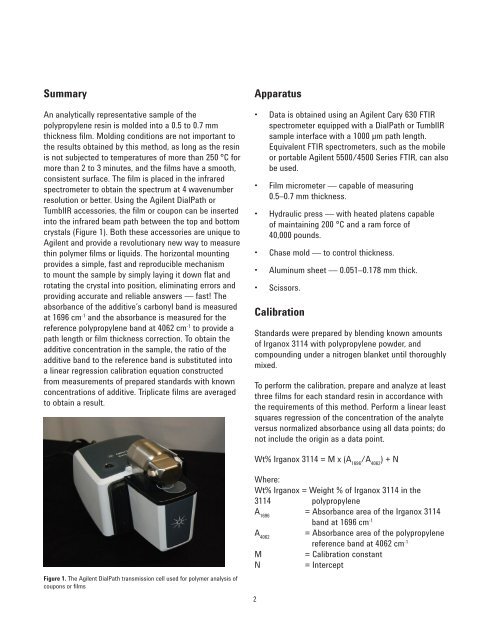Application Compendium - Agilent Technologies
Application Compendium - Agilent Technologies
Application Compendium - Agilent Technologies
You also want an ePaper? Increase the reach of your titles
YUMPU automatically turns print PDFs into web optimized ePapers that Google loves.
Summary<br />
An analytically representative sample of the<br />
polypropylene resin is molded into a 0.5 to 0.7 mm<br />
thickness film. Molding conditions are not important to<br />
the results obtained by this method, as long as the resin<br />
is not subjected to temperatures of more than 250 °C for<br />
more than 2 to 3 minutes, and the films have a smooth,<br />
consistent surface. The film is placed in the infrared<br />
spectrometer to obtain the spectrum at 4 wavenumber<br />
resolution or better. Using the <strong>Agilent</strong> DialPath or<br />
TumblIR accessories, the film or coupon can be inserted<br />
into the infrared beam path between the top and bottom<br />
crystals (Figure 1). Both these accessories are unique to<br />
<strong>Agilent</strong> and provide a revolutionary new way to measure<br />
thin polymer films or liquids. The horizontal mounting<br />
provides a simple, fast and reproducible mechanism<br />
to mount the sample by simply laying it down flat and<br />
rotating the crystal into position, eliminating errors and<br />
providing accurate and reliable answers — fast! The<br />
absorbance of the additive’s carbonyl band is measured<br />
at 1696 cm -1 and the absorbance is measured for the<br />
reference polypropylene band at 4062 cm -1 to provide a<br />
path length or film thickness correction. To obtain the<br />
additive concentration in the sample, the ratio of the<br />
additive band to the reference band is substituted into<br />
a linear regression calibration equation constructed<br />
from measurements of prepared standards with known<br />
concentrations of additive. Triplicate films are averaged<br />
to obtain a result.<br />
Figure 1. The <strong>Agilent</strong> DialPath transmission cell used for polymer analysis of<br />
coupons or films<br />
Apparatus<br />
• Data is obtained using an <strong>Agilent</strong> Cary 630 FTIR<br />
spectrometer equipped with a DialPath or TumblIR<br />
sample interface with a 1000 μm path length.<br />
Equivalent FTIR spectrometers, such as the mobile<br />
or portable <strong>Agilent</strong> 5500/4500 Series FTIR, can also<br />
be used.<br />
• Film micrometer — capable of measuring<br />
0.5–0.7 mm thickness.<br />
• Hydraulic press — with heated platens capable<br />
of maintaining 200 °C and a ram force of<br />
40,000 pounds.<br />
• Chase mold — to control thickness.<br />
• Aluminum sheet — 0.051–0.178 mm thick.<br />
• Scissors.<br />
Calibration<br />
Standards were prepared by blending known amounts<br />
of Irganox 3114 with polypropylene powder, and<br />
compounding under a nitrogen blanket until thoroughly<br />
mixed.<br />
To perform the calibration, prepare and analyze at least<br />
three films for each standard resin in accordance with<br />
the requirements of this method. Perform a linear least<br />
squares regression of the concentration of the analyte<br />
versus normalized absorbance using all data points; do<br />
not include the origin as a data point.<br />
Wt% Irganox 3114 = M x (A 1696 /A 4062 ) + N<br />
Where:<br />
Wt% Irganox = Weight % of Irganox 3114 in the<br />
3114 polypropylene<br />
A = Absorbance area of the Irganox 3114<br />
1696<br />
band at 1696 cm-1 A 4062<br />
2<br />
= Absorbance area of the polypropylene<br />
reference band at 4062 cm -1<br />
M = Calibration constant<br />
N = Intercept

















